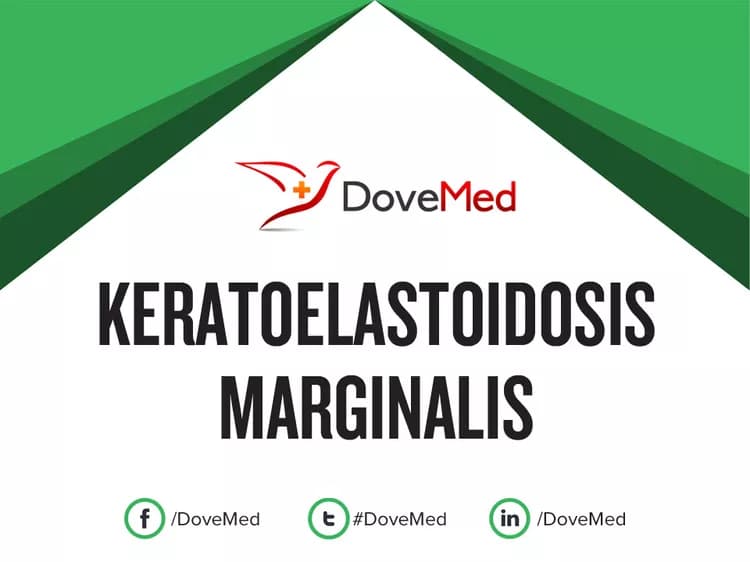What are the other Names for this Condition? (Also known as/Synonyms)
- Collagenous and Elastotic Marginal Plaque of Hands (CEMPHs)
- Keratoelastoidosis Marginalis of Hands (KEMH)
- Marginal Keratoderma of Palms
What is Keratoelastoidosis Marginalis? (Definition/Background Information)
- Keratoelastoidosis Marginalis is a benign skin condition, characterized by degenerative collagenous plaque of the palms. It is a rare type of marginal keratoderma (thickening of skin)
- The skin condition is generally seen in middle-aged and older adults and is caused by skin damage through chronic exposure to sunlight. Keratoelastoidosis Marginalis is described as a variant of solar elastosis
- Both the palms are typically affected. It starts off with the presence of tiny papules that over time, fuse to form larger plaques. This may affect the fingers too
- A diagnosis of Keratoelastoidosis Marginalis can be made by clinical exam, skin exam, and various other diagnostic tools including dermoscopy and wood’s lamp examination
- Keratoelastoidosis Marginalis is treated using moisturizers, topical creams, and skin softeners. The prognosis of the condition depends upon the severity of the symptoms
Who gets Keratoelastoidosis Marginalis? (Age and Sex Distribution)
- Keratoelastoidosis Marginalis may be observed during middle-age and in older adults (40-80 years)
- The condition affects both males and females, but a female predominance is generally noted
- It is seen worldwide and all racial and ethnic groups may be affected
- However, the condition is diagnosed more in light-skinned individuals
What are the Risk Factors for Keratoelastoidosis Marginalis? (Predisposing Factors)
The risk factors for Keratoelastoidosis Marginalis include the following:
- Long-term sun exposure
- Trauma due to hard manual labor that takes place over many years to decades
- Caucasians are higher prone to this skin condition
- Advancing age
It is important to note that having a risk factor does not mean that one will get the condition. A risk factor increases one’s chances of getting a condition compared to an individual without the risk factors. Some risk factors are more important than others.
Also, not having a risk factor does not mean that an individual will not get the condition. It is always important to discuss the effect of risk factors with your healthcare provider.
What are the Causes of Keratoelastoidosis Marginalis? (Etiology)
Keratoelastoidosis Marginalis is a benign skin condition that is considered to be an aging process, with the following contributory factors:
- Sun exposure: Ultraviolet (UV) light of sun causes degeneration of skin tissue
- It can also develop from repeated or chronic trauma due to manual labor (occupation-related)
Unlike acrokeratoelastoidosis (another skin condition affecting the hands and feet), Keratoelastoidosis Marginalis is not a genetic disorder.
What are the Signs and Symptoms of Keratoelastoidosis Marginalis?
The signs and symptoms associated with Keratoelastoidosis Marginalis may include:
- The presence small papules, which with time, merge to form plaques
- The collagenous plaques are present on the palms; usually, both the hands are involved
- The condition is progressive and it can result in calcified nodules
- The fingers may be affected, with the index finger and thumb being more commonly involved
- Hair and nails are not affected
How is Keratoelastoidosis Marginalis Diagnosed?
The diagnosis of Keratoelastoidosis Marginalis may involve:
- A complete evaluation of medical history along with a thorough examination of the skin lesions by a dermatologist
- Dermoscopy: It is a diagnostic tool where a dermatologist examines the skin using a special magnified lens
- Wood’s lamp examination: In this procedure, the healthcare provider examines the skin using ultraviolet light. It is performed to examine the change in skin pigmentation
- Skin biopsy: A skin tissue biopsy is performed and sent to a laboratory for a pathological examination. The pathologist examines the biopsy under a microscope. After putting together clinical findings, special studies on tissues (if needed) and with microscope findings, the pathologist and clinician arrive at a definitive diagnosis
Many clinical conditions may have similar signs and symptoms. Your healthcare provider may perform additional tests to rule out other clinical conditions to arrive at a definitive diagnosis.
What are the possible Complications of Keratoelastoidosis Marginalis?
Complications associated with Keratoelastoidosis Marginalis may include the following:
- Emotional stress due to the skin condition
- Cosmetic concerns
- The skin condition is known to get progressively worse with time
How is Keratoelastoidosis Marginalis Treated?
Keratoelastoidosis Marginalis is a skin condition that can be difficult to treat. However, the skin symptoms may be addressed through measures such as:
- Use of moisturizing creams and lotions; use of ointments containing vitamin D
- Use of topical and systemic retinoids
- Cryotherapy
- Administration of keratolytics (medicine containing salicylic acid)
How can Keratoelastoidosis Marginalis be Prevented?
Currently, it may not be possible to prevent Keratoelastoidosis Marginalis. However, the following measures may be considered. They may also help prevent the condition from getting much worse.
- Avoiding chronic exposure to direct sunlight
- Using protective gear, such as gloves for the hands, while working
- Initiating or considering appropriate occupational health and safety measures
What is the Prognosis of Keratoelastoidosis Marginalis? (Outcomes/Resolutions)
The prognosis of Keratoelastoidosis Marginalis may depend on the severity of the signs and symptoms. In most cases, the prognosis is good with appropriate treatment.
- However, in general, the condition is difficult to treat and it may present treatment challenges
- Regular follow up visits with the healthcare provider are important and encouraged
Additional and Relevant Useful Information for Keratoelastoidosis Marginalis:
- A study of 500 patients at a dermatology clinic in Puducherry, India, revealed the incidence rate of Keratoelastoidosis Marginalis as 0.4% (or 1 in 250 cases)
- Cleaning the skin too hard with strong chemicals or soaps may aggravate the skin condition. Care must be taken avoid strong soaps and chemicals that could potentially worsen the condition
Related Articles
Test Your Knowledge
Asked by users
Related Centers
Related Specialties
Related Physicians
Related Procedures
Related Resources
Join DoveHubs
and connect with fellow professionals



0 Comments
Please log in to post a comment.